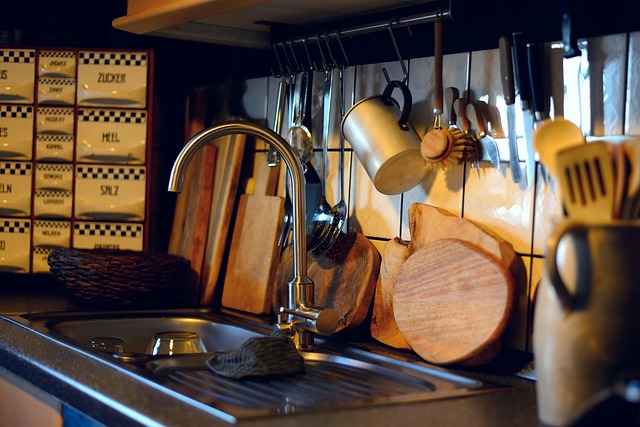Open kitchen-living spaces combine cooking and entertainment areas for modern, social living. Key design elements include seamless appliance integration, strategic layout, smart technology, natural light optimization, neutral color palettes with vibrant accents, and balanced furniture arrangement. Materials like natural stones, timber finishes, metals, and glass create aesthetic appeal and functional hubs for communal interaction.
Seamless kitchen designs for open spaces are transforming modern living. Combining cooking, dining, and living areas creates a vibrant hub that fosters connection and convenience. This article explores the allure of open kitchen-living spaces, delving into key design elements that blend functionality with stunning aesthetics. From materials and colors to lighting strategies, we uncover secrets to crafting a truly harmonious and inviting space that elevates your everyday experiences. Discover how to maximize this versatile layout’s potential.
- Understanding Open Kitchen-Living Spaces: The Concept and Benefits
- Key Elements of Seamless Kitchen Design for Open Spaces
- Creating a Functional and Esthetically Pleasing Layout
- Materials, Colors, and Lighting: Enhancing the Open Kitchen Experience
Understanding Open Kitchen-Living Spaces: The Concept and Benefits
Open kitchen-living spaces have become a popular design choice for modern homes, seamlessly blurring the lines between cooking and entertainment areas. This concept revolves around creating a unified, expansive environment where the kitchen is no longer isolated but seamlessly integrated into the overall living space. By eliminating traditional barriers, open kitchen designs foster a sense of openness, connection, and continuity, making them ideal for today’s social and entertaining needs.
One of the key benefits of an open kitchen-living space is its ability to enhance social interaction. With all eyes on the chef, these layouts encourage gathering and conversation around the central cooking area, transforming meals into a communal affair. Moreover, open designs offer versatility in terms of furniture placement and layout adjustments, allowing homeowners to adapt the space for various activities, from casual dining to movie nights or game evenings.
Key Elements of Seamless Kitchen Design for Open Spaces
In designing seamless kitchens for open spaces, such as an open kitchen living area, several key elements come into play to create a cohesive and functional layout. The first consideration is the integration of appliances and cabinetry with the overall design of the space. This means choosing styles, materials, and colors that complement the surrounding decor while ensuring all necessary amenities are accessible. For instance, a modern, minimalist aesthetic might feature sleek stainless steel appliances and clean-lined cabinets in neutral tones to blend seamlessly with the living area.
Another vital aspect is the flow and functionality of the open kitchen. The layout should encourage movement and interaction between the cooking area, dining space, and living room. This can be achieved through thoughtful placement of countertops and islands that double as seating or serving areas. Open shelves and floating cabinets can also help create a sense of continuity and visual balance, connecting the kitchen to the rest of the open concept design. Additionally, incorporating smart technology into the kitchen fixtures and appliances enhances both functionality and style in this shared living space.
Creating a Functional and Esthetically Pleasing Layout
In designing an open kitchen living space, functionality and aesthetics go hand in hand. The goal is to create a layout that not only accommodates daily routines but also enhances the overall visual appeal of the area. One effective strategy is to maximize natural light by incorporating large windows or skylights, making the space bright and inviting. Additionally, using neutral color palettes with accents of vibrant colors can add visual interest without overwhelming the senses.
Seamless integration of various elements such as appliances, cabinets, and countertops is crucial for a cohesive look. Open shelving and island counters not only provide additional storage and workspace but also create a sense of openness and continuity. Careful consideration should be given to the placement of furniture to ensure easy movement and traffic flow, ensuring that the space remains functional even when it’s bustling with activity.
Materials, Colors, and Lighting: Enhancing the Open Kitchen Experience
In crafting seamless kitchen designs for open spaces, materials play a pivotal role in defining the overall aesthetic and functionality. Natural stones like marble or granite offer both durability and an elegant, timeless appeal, complementing modern open kitchen living spaces. Alternatively, timber finishes add warmth and texture, creating a cozy yet inviting atmosphere. For a more contemporary look, sleek metal surfaces and glass accents enhance the open, airy feel, making the kitchen the heart of the home.
When it comes to colors, neutral tones like whites, grays, and beiges are popular choices for open kitchens as they create a sense of space and balance. Accents of deeper shades or vibrant pops of color can add visual interest without overwhelming the area. In an open kitchen living space, strategic lighting is key to enhancing the ambiance. Task lighting over countertops ensures functionality while recessed lights and pendant fixtures create layers of warmth, drawing attention to specific areas and fostering a welcoming environment that encourages gathering and conversation.
Open kitchen-living spaces offer a modern, spacious, and interconnected lifestyle. To fully realize this concept, seamless kitchen design is key. By integrating functional elements, considering aesthetics, and strategically choosing materials, colors, and lighting, you can create an inviting, efficient, and visually stunning open kitchen that serves as the heart of your home. Embrace the benefits of this layout and enhance your living experience.
